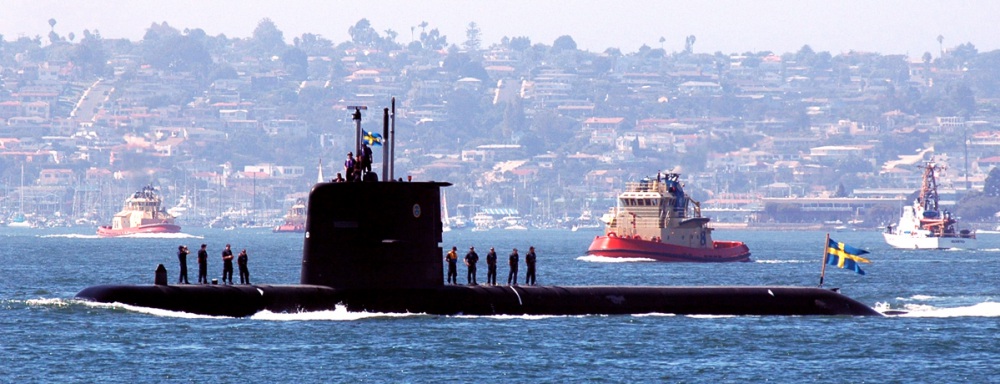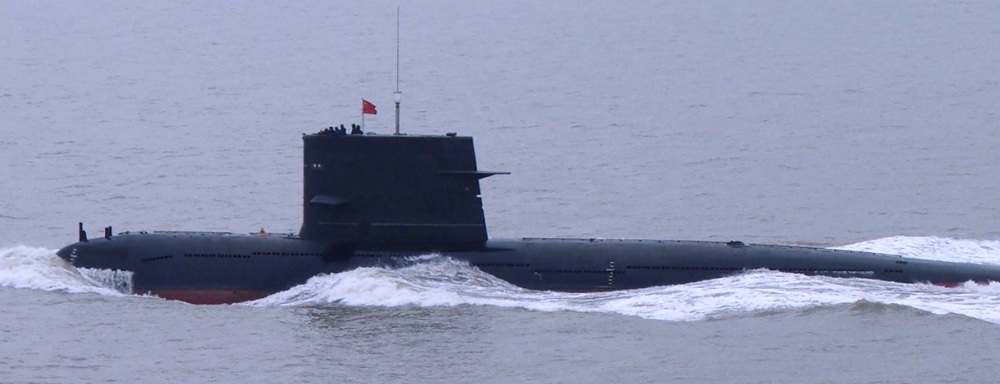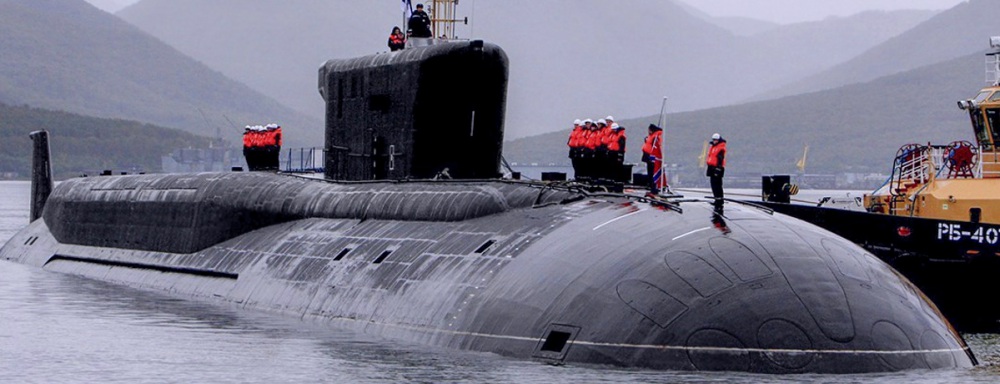
Capabilities at a Glance
Based at Karlskrona, the Royal Swedish Navy operates a submarine flotilla of five diesel-electric submarines: three Gotland-class vessels and two Södermanland-class (previously Västergötland-class) vessels. The Swedish Navy was the first to operate diesel vessels using an air-independent propulsion (AIP) system based on the Stirling engine.1
Total Submarines in Fleet: 5
- Ballistic Missile Submarines (SSBNs): 0
- Nuclear-Powered attack submarines (SSNs): 0
- Diesel-electric attack submarines (SSKs): 5
- Air-independent propulsion (AIP) enabled: 5/5
Submarines
History
Sweden considers its submarines integral to its national defense. While originally assigned to the Baltic Sea region to counter the threat of Soviet invasion, Sweden’s submarines have recently expanded their area of operation. These vessels have begun to participate in multinational rapid reaction exercises acting in waters such as the North Sea, the Atlantic, the Pacific, the Bay of Biscay, and the Mediterranean. Their new tasks focus on reconnaissance, intelligence gathering, and surveillance.2
Sweden planned to develop a new submarine type, the Viking, but was forced to terminate its plans after Norway and Denmark withdrew from the development program in 2003 and 2004 respectively.3 Subsequently, Sweden’s Defense Materiel Administration (FMV) was tasked with initiating the preliminary planning for an even more modern submarine, the A26 class, to replace its Gotland-class vessels.4
Modernization and Current Capabilities
In 2014, after acquiring Kockums from TKMS (ThyssenKrupp Marine Systems), Saab and the Swedish Defense Material Administration (FMV) came to an agreement regarding the upgrades on the Gotland-class vessels and the production of two Type A26 submarines. Under the 248 million USD deal, Kockums completed the upgrade of the HSwMS Gotland and relaunched the vessel in June 2018.5 In June 2019, Kockums completed the upgrade of the HSwMS Uppland and relaunched the vessel.6
In January 2019, Sweden announced the names of its two new A26-class submarines: HSwMS Blekinge and HSwMS Skåne. The first boat began construction in June 2022 and was originally scheduled for delivery in 2024, but has been delayed to 2027,7 The second boat was due for delivery in 2025, but will now be delivered in 2028.8 Like Sweden’s current fleet, the new A26 submarines will be equipped with Stirling AIP. The Stirling AIP was designed specifically for intelligence and stealth operations in shallow waters in addition to its open sea capabilities.9 The A26 vessels will also have a large bow section from which unmanned underwater vehicles (UUVs) can be launched and special forces can be transported. Additionally, this section can be used for reconnaissance, mine detection, mine laying, underwater mapping, and warfighting.10 Currently, Kockums is investigating several ways to improve communications with onshore command without giving up the submarine’s position, including the possible use of UUVs for communications purposes or new antennas on the submarine.11
The Swedish navy added a third submarine to its budget due to the increasing seabed warfare seen during the Russia-Ukraine conflict.12 The Swedish navy saw how it was unprepared during the suspected Russian attacks on the Nord Stream pipeline and is looking to rectify that issue.13 The new A26 submarines will be equipped with the ability to sense and interact with underwater pipes for this very reason.14
Ship Biographies
Gotland-Class
Sweden possesses three Gotland-class diesel-electric attack submarines. These submarines are 60.4 meters long with a 6.2-meter-wide beam and can travel up to 20 knots when submerged. These vessels were the first in the world to feature a Stirling engine air-independent propulsion (AIP) system. Their weapons systems are capable of firing torpedoes using four 533mm and two 400mm torpedo tubes.15
Södermanland-Class
Sweden possesses two of Södermanland-class (formerly Västergötland-class) diesel-electric attack submarines. These submarines are 60.5 meters long with a 6.1-meter-wide beam and can travel up to 20 knots when submerged. Their weapons systems are capable of firing torpedoes using six 533mm and three 400mm torpedo tubes.
Import and Export Behavior
Imports
Sweden does not import submarines.
Exports
Swedish shipyard Kockums began producing submarines for the Swedish Navy in 1914 but did not export vessels until the 1980s. This was largely due to Sweden’s policy of neutrality in international conflicts.16 Sweden’s change in export behaviour has been attributed to trying to retain the ability to develop new boats without facing increasingly prohibitive costs.17 In 1999, Kockums was incorporated into Germany’s Howaldtswerke-Deutsche Werft (HDW), then became part of ThyssenKrupp Marine Systems (TKMS) in January 2005. In June 2014, Saab acquired Kockums.18
Sweden’s Kockums shipyard exports three classes of submarines to Singapore, Australia, and Denmark.19 Kockums also refit deployed Japanese submarines with its Stirling AIP system.20 Kockums offers three submarine classes for export:
- Gotland-class: hybrid diesel-electric/AIP patrol submarines, with an AIP system based on the Stirling engine
- Collins-class: diesel-electric, ocean-going, long-range patrol submarines, designed for the Australian Navy
- A26: diesel-electric/AIP submarines with advanced technology to enhance littoral abilities.
- Saab has begun to offer the new Blekinge submarine on the export market in three different sizes, from small boats for shorter ranges to larger boats for blue water navies.21
Explore the Collection
Australia Submarine Capabilities
Brazil Submarine Capabilities
Chile Submarine Capabilities
China Submarine Capabilities
France Submarine Capabilities
Germany Submarine Capabilities
Greece Submarine Capabilities
India Submarine Capabilities
Indonesia Submarine Capabilities
Iran Submarine Capabilities
Israel Submarine Capabilities
Italy Submarine Capabilities
Japan Submarine Capabilities
Malaysia Submarine Capabilities
Netherlands Submarine Capabilities
North Korea Submarine Capabilities
Pakistan Submarine Capabilities
Russia Submarine Capabilities
Singapore Submarine Capabilities
South Korea Submarine Capabilities
Your are currently on
Sweden Submarine Capabilities
Taiwan Submarine Capabilities
United States Submarine Capabilities
Submarine Detection and Monitoring: Open-Source Tools and Technologies
Stay Informed
Sign up for our newsletter to get the latest on nuclear and biological threats.
More on
United States Submarine Capabilities
Overview of the United States' submarine capabilities and import-export behavior.

China Submarine Capabilities
A highlight of global trends in the sale and acquisition of diesel- and nuclear-powered submarines by country with capabilities, imports and exports. (CNS)

Russia Submarine Capabilities
Overview of Russia's submarine capabilities and import-export behavior.
Glossary
- SSBN
- Ship, Submersible, Ballistic, Nuclear: A hull classification for a submarine capable of launching a ballistic missile. The "N", or nuclear, refers to the ship's propulsion system. SSBN's are generally reserved for strategic vessels, as most submarine launched ballistic missiles carry nuclear payloads. A non-strategic vessel carries the designation SSN, or attack submarine.
- Diesel-electric submarine
- Diesel-electric submarine: A submarine with a diesel-electric transmission. Diesel-electric transmissions require access to oxygen for the diesel generator to charge the submarine’s batteries or drive the motor. This type of submarine is thus louder and must surface more frequently than a nuclear-powered submarine. A diesel-electric submarine can fire conventional cruise missiles against land targets, and in theory, can also carry nuclear-tipped cruise missiles. Diesel-electric submarines are significantly cheaper to build and purchase than nuclear-powered vessels, which makes them the vessel of choice for smaller navies.
- Air Independent Propulsion Technology (AIP)
- Air Independent Propulsion Technology (AIP): A propulsion system that uses liquid (or compressed) oxygen or hydrogen fuel cells, thereby allowing submarines to stay submerged for longer periods without the need for external sources of oxygen. This increased endurance also increases a submarine’s survivability.
Sources
- Bo Rask, “The Swedish submarine force in the future,” Naval Forces, Vol. 24, No. 3 (2003), pp. 85; in ProQuest Information and Learning Company, http://proquest.umi.com.
- Bo Rask, “The Swedish submarine force in the future,” Naval Forces, Vol. 24, No. 3 (2003), pp. 85, in ProQuest Information and Learning Company, http://proquest.umi.com; “Swedish Submarine Continues to Play Important Role in Joint Training,” United States Navy, 20 December 2005, www.navy.mil.
- Richard Scott, “Viking Submarine to Steer Two-Nation Course,” Jane’s Defence Weekly, 4 June 2003, www.lexisnexis.com; Richard Scott, “Boat Decision Puts Viking Project in the Shallows,” Jane’s Defence Weekly, 23 June 2004, www.lexisnexis.com.
- “Kockums Receives Overall Design Order for Next-Generation Submarine,” Kockums, 25 February 2010, www.kockums.se; “Sweden Plans New Sub Class,” Defense Technology International, 1 April 2010, www.lexisnexis.com.
- “Saab Signs Contract for A26 Submarines and Mid-Life Upgrade for Gotland-class Submarines,” SAAB, 30 June 2015, www.saab.com; “Swedish AIP submarine HSwMS Gotland completes mid-life upgrade,” Navaltoday.com, 18 June 2018.
- “Saab Story: Swedens New A26 Submarines,” Defense Industry Daily, 20 June 2019, www.defenseindustrydaily.com.
- “Saab Kockums Builds New Processes, Skills, and Capabilities in Delivering A26,” Naval News, 19 October 2022, navalnews.com.
- “Sweden Announces Names of New A26 AIP Submarines,” Naval Today, 17 January 2019, https://navaltoday.com.
- “The Way Ahead – for Kockums A26,” Kockums, 26 August 2011, www.kockums.se.
- Magnus Forsberg, “Ledningsplattform med tentakler,” Protec, No. 1, 2006, Swedish Defence Materiel Administration, www.fmv.se.
- Magnus Forsberg, “Ledningsplattform med tentakler,” Protec, No. 1, 2006, Swedish Defence Materiel Administration, www.fmv.se.
- “Sweden’s A-26 Submarine Creates New Possibilities for Seabed Warfare,” Naval News, 16 November 2022, navalnews.com.
- “Saab to Upgrade Swedish Submarine for $44 Million,” The Defense Post, 16 September 2022, thedefensepost.com.
- “Sweden’s A-26 Submarine Creates New Possibilities for Seabed Warfare,” Naval News, 16 November 2022, navalnews.com.
- “SSK Gotland Class (Type A19),” Naval Technology, accessed 8 August 2019, www.naval-technology.com.
- Anthony Watts, Jane’s Underwater Warfare Systems: 2003-2004 (Coulsdon: Jane’s Information group, 2002), pp. 31-47.
- Richard Scott, “Viking submarine to steer two-nation course,” Jane’s Defence Weekly, 4 June 2003, www.janes.com.
- Robert Wall, “Saab Buys Submarine Builder ThyssenKrupp Marine Systems AB,” Wall Street Journal, 29 June 2014, wwww.wsj.com.
- P. Lewis Young, “The Royal Australian Navy’s new submarine selection,” Asian Defence Journal, August 1984, pp. 52; in Derek Wollner; “Kockums receives Singapore order to two submarines,” Kockums, 4 November 2005, http://kockums.se.
- “Breakthrough in Japan for Stirling AIP,” Kockums, 11 July 2005, http://kockums.se.
- “Sweden’s new submarine could shift balance of power in the Baltic Sea,” New Atlas, 1 August 2022, newatlas.com.
